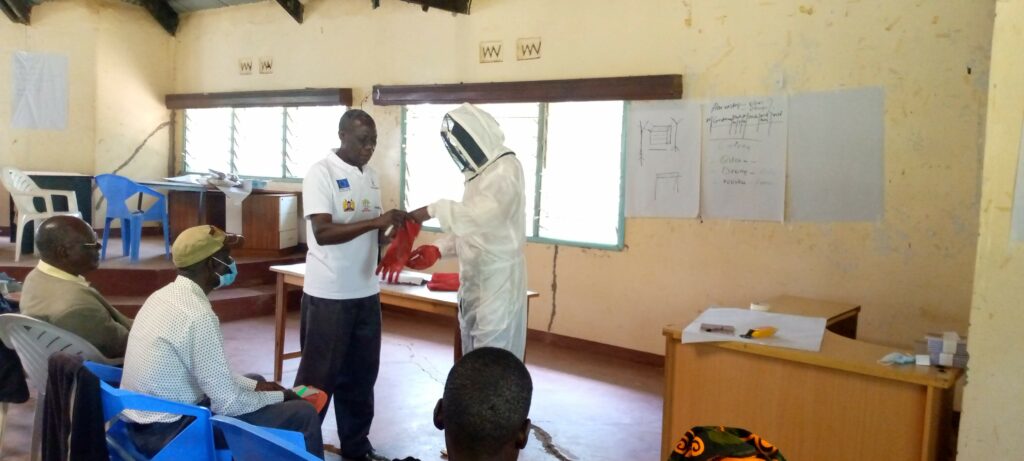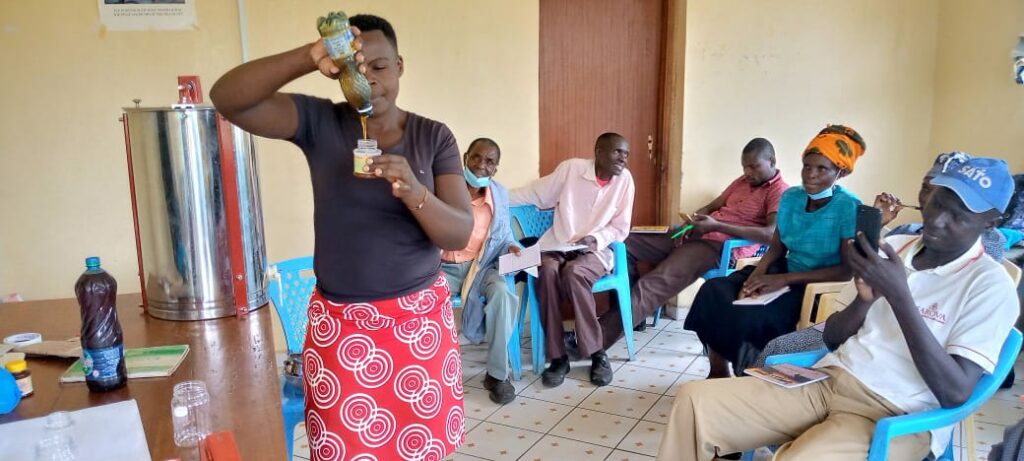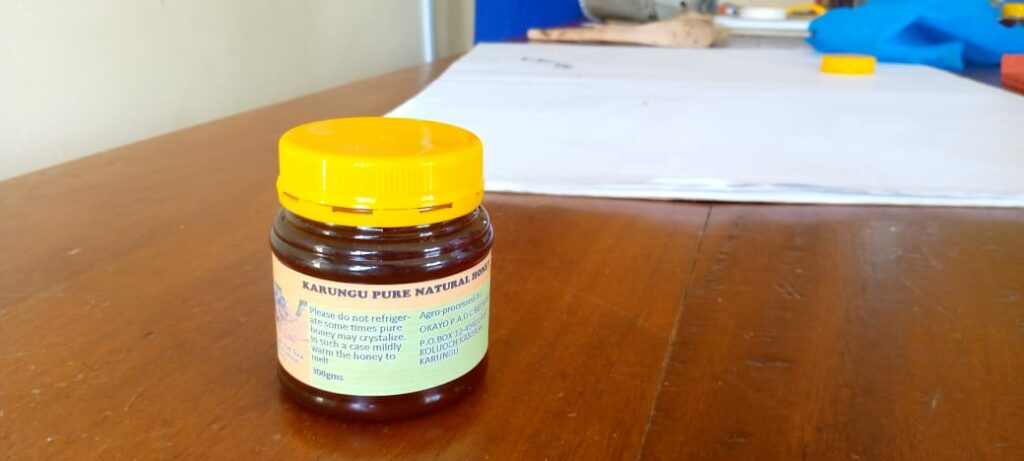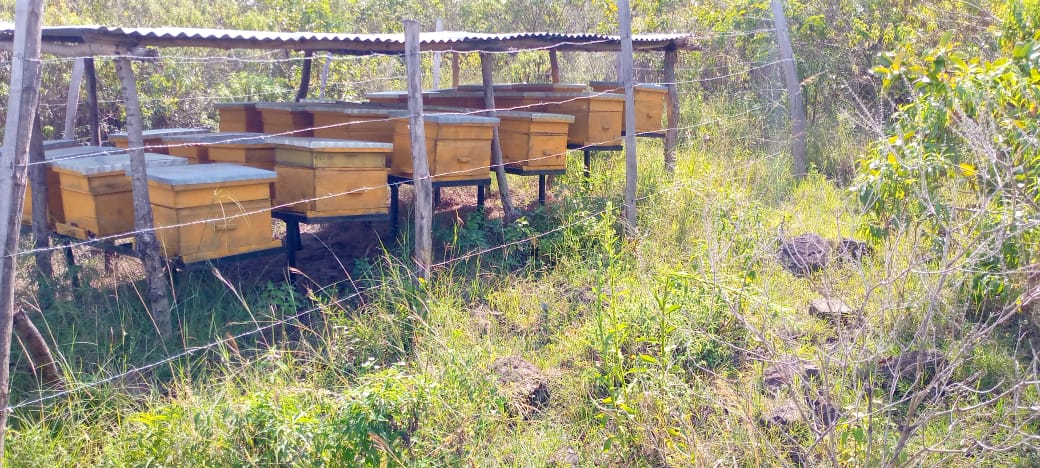By Grace Koech
In the wake of the COVID-19 pandemic, the desire to get healthier, amid climate change and widening gaps in food security and nutrition are of concern, hence the need for the development and strengthening of existing rural delivery systems to improve the situation. Managing multifunctional landscapes by incorporating trees under Farmer Managed Natural Regeneration (FMNR), tree planting and nursery operations can provide farmers with various avenues to dietary diversity and income sources.
Integrating bee farming within the tree-based land restoration initiatives adds to the available food, income sources, and employment opportunities for men, women, and youth as each has a role. Several products that include honey, pollen, venom, propolis, royal jelly, and wax are harvested from a bee farm. Due to the excellent pollination ability of bees, increased crop yields occur where bee farms are established adjacent to agricultural land.
In Nyatike sub-county, Migori county in Kenya, farmers are producing honey individually or in groups within their FMNR plots, or in tree plantations. Tree nurseries provide several species of trees that farmers plant to provide food for the bees. The county government of Migori and partners have invested in bee farming in Nyatike, however, productivity of bee products is below market demand.
Like any other farms, bee farms require regular inspection without interfering with the bees to avoid absconding. According to Stephen Kamolo, a Livestock Officer in Migori county, there is a difference between a bee haver and a beekeeper. Bee havers set their hives and wait for the products while keepers monitor their farm, water the bees, supplement feeds during the dry season, and check and control invaders. One way to increase productivity is to be a beekeeper, he alluded.
 Mr. Kamolo, an officer with the Migori County Government, demonstrates how to put on a bee suit, which is required before hive inspection and harvesting. Photo: Regreening Africa/Grace Koech
Mr. Kamolo, an officer with the Migori County Government, demonstrates how to put on a bee suit, which is required before hive inspection and harvesting. Photo: Regreening Africa/Grace Koech
“I am a beekeeper but how do I know the exact time when the bee products are ready for harvesting?” asked Peres Odhiambo, a participant in a training workshop on adding value to tree-based restoration interventions. Several factors indicate the products are ready for harvesting, a) bees roaming outside the hives, b) change in bee behaviour i.e., bees become hostile when the honey is ready, c) presence of oily materials at the bee entrance and d) smell of honey around the hives.
The harvesting process is another factor determining productivity, limiting the interference of the bees by using a smoker to confuse the bees reduces cases of bees migrating from the hives. Hygiene practices and the use of protective clothes enhance the quality of the harvested products.
‘’What material should be used to light the smoker? ‘’ Asked Mariana Ajwang. The twigs used to light the smoker should be harvested from the trees that bees feed, to maintain the taste of the bee products.
Apart from beehive management and proper harvesting practices, value addition to bee products maximizes profits for the farmers. Cost-effective value add options such as packaging honey in containers of varied sizes allow farmers to meet the target market.
 One of the forms of value addition demonstrated by a participant is honey packaging. Photo: Regreening Africa/Grace Koech
One of the forms of value addition demonstrated by a participant is honey packaging. Photo: Regreening Africa/Grace Koech
Joyce Achieng mentioned that she was mesmerized by the training and how minimal consistent efforts can bring her more income, more food hence better health because of better management of the bee farms. ‘’We have trees on our farms that are appropriate for bee farming, and now with the skills that we have acquired, accessing modern beehives would help us better our yield’’ emphasized Ms. Achieng. ‘’Is it possible for some farmers to be selected and trained in the fabrication of beehives? Now one beehive cost KES 13,000 in Migori and sometimes it is not of good quality’’, she said.
 Locally produced honey, packaged and labeled by a Community Based Organization in Migori County, Kenya. Photo: Regreening Africa/Grace Koech
Locally produced honey, packaged and labeled by a Community Based Organization in Migori County, Kenya. Photo: Regreening Africa/Grace Koech
“We have a major challenge of thieves into the bee farm, how can this be addressed?’’ Joseph Marwa an officer from World Vision Kenya mentioned that farmers in Kuria had a similar challenge which is no longer a problem because they raised a campaign that every bee farmer donated a hive to the neighbour who didn’t have one and that way, they managed to control invasion into the bee farms by thieves as everyone had some bee products from their farms.
Equipped with the knowledge, Ms. Grace Koech of Center for International Forestry Research-World Agroforestry (CIFOR-ICRAF)and Stephen Kamolo of Migori county government, called upon the Training of trainers to scale the knowledge first to their families as everyone has a role to play in a bee farm and second, to their respective communities for better benefits from having trees on farms.
The training participants highlighted four main areas for further support to allow them to upgrade their value chains:
- Support the groups with training on how to fabricate beehives, the groups have tree species that support the production of beehives which can also create job opportunities
- Build capacity of farmers on related value chain for example nursery operators to produce tree species that support bee farming that include fabrication of beehives, bee forage, baiting of the bees, beehives stand, and fencing materials among others.
- Follow-up visits to bee farms for technical backstopping.
- Linking the bee farmers with successful groups for co-learning for better production and income
The training workshop organized by the Regreening Africa programme and co-facilitated by the Ministry of Agriculture, World Vision Kenya, and CIFOR-ICRAF was delivered through lecture sessions, group discussion, plenary, demonstration, and field visits; with the objective to add value to the trees on farms by building the capacity of bee farmers on beehive management, honey harvesting, and value addition for higher production, increased food and health, better markets, and higher income.
This story was produced with the financial support of the European Union. Its contents are the sole responsibility of Regreening Africa and do not necessarily reflect the views of the European Union.

